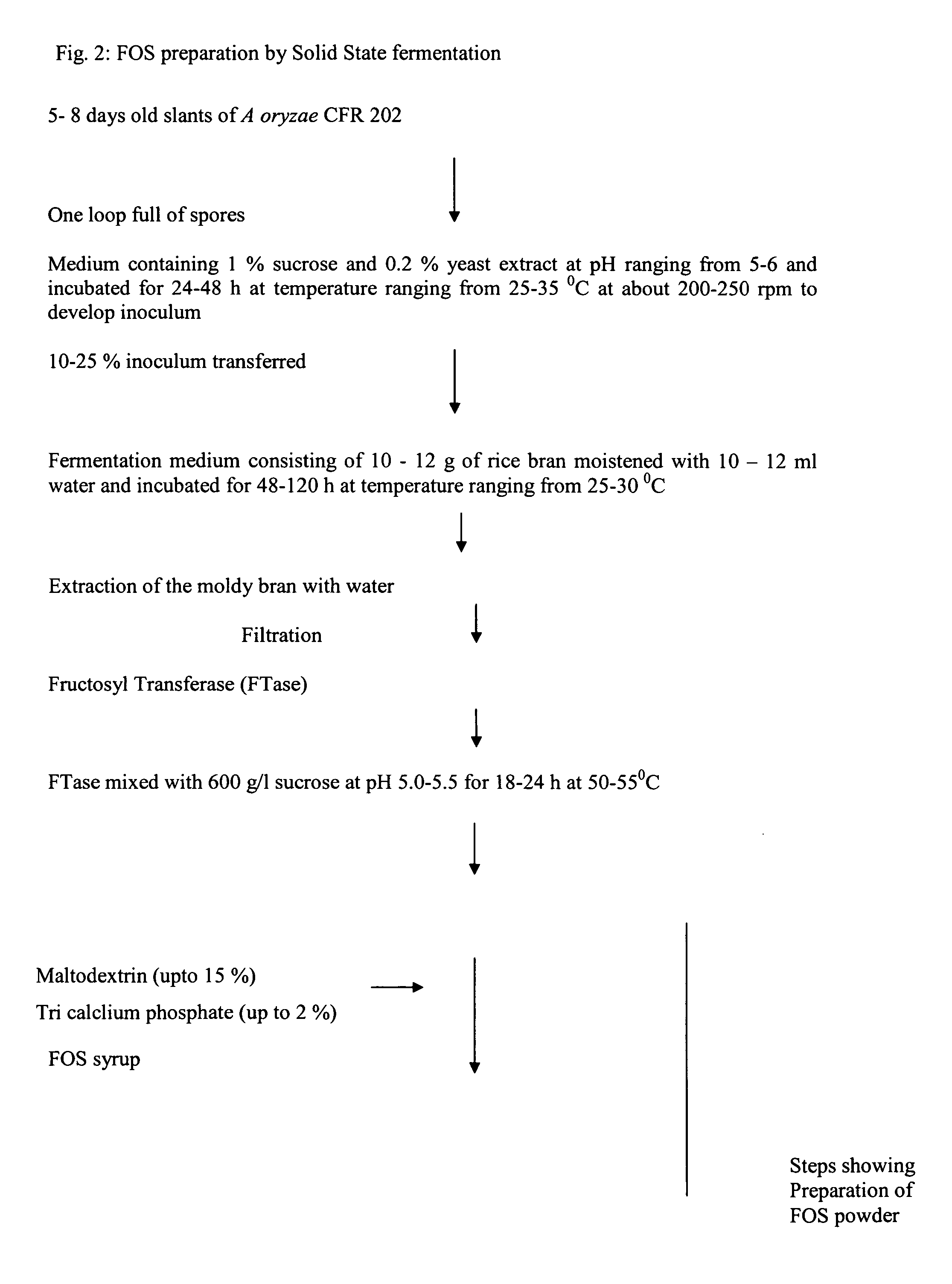Process for preparation of fructooligosaccharides (FOS)
a technology of fructooligosaccharide and process, which is applied in the field of fructooligosaccharide preparation, can solve the problems of inert gas having to be dispersed into suspension, difficult and complicated techniques suggested, and difficult and complicated processes, and achieve the effect of improving the sweetness of fos
- Summary
- Abstract
- Description
- Claims
- Application Information
AI Technical Summary
Benefits of technology
Problems solved by technology
Method used
Image
Examples
example 1
Aspergillus oryzae was grown in 50 ml medium consisting of 1% sucrose and 0.2% yeast extract (pH 5.5) at 30±1° C. for 24 h at 250 rpm to develop inoculum. 20% v / v of the inoculum was transferred to 50 ml fermentation medium in a 250 ml conical flask containing 10% sucrose, 0.8% yeast extract, 0.03% MgSO4, 7H2O, 2% NaNO3, 0.4% K2 HPO4, 0.9% KH2PO4, 0.6% NaCl and 1% NH4Cl and incubated at 250 rpm for 90 h at 30±1° C. The pellets were separated from the culture fluid by filtration using filter paper (Whatman No.2). The culture fluid obtained was used as the source of extracellular enzyme for the production of FOS. 0.25 ml of the culture fluid was mixed with 1.75 ml of the substrate (600 g / L jaggery) and incubated for 18 h at 55° C. at pH 5.15. The reaction products were analyzed by HPLC using refractive index detector. The maximum FOS yield obtained was 41.98% of the initial sucrose which consisted of 32.07% Kestose and 9.91% Nystose (Table 1; FIG. 1).
example 2
Aspergillus oryzae was grown in 50 ml medium consisting of 1% sucrose and 0.2% yeast extract (pH 5.5) at 30±1° C. for 24 h at 250 rpm to develop inoculum. 20% v / v of the inoculum was transferred to 50 ml fermentation medium in a 250 ml conical flask containing 10% extra jaggery, 0.08% yeast extract, 0.03% MgSO4, 7H2O, 2% NaNO3, 0.4% K2 HPO4, 0.9% KH2PO4, 0.6% NaCl and 1% NH4Cl and incubated at 250 rpm for 90 h at 30±1° C. The pellets were separated from the culture fluid by filtration using filter paper (Whatman No.2). The culture fluid obtained was used as the source of extracellular enzyme for the production of FOS. 0.25 ml of the cultu4re fluid was mixed with 1.75 ml of the substrate (600 g / L jaggery) and incubated for 18 h at 55° C. at pH 5.15. The reaction was stopped by keeping the reaction mixture in boiling water bath. The reaction products were analyzed by HPLC using refractive index detector. The maximum FOS yield obtained was 40.03% of the initial sucrose which consisted ...
example 3
Aspergillus oryzae was grown in 50 ml medium consisting of 1% sucrose and 0.2% yeast extract (pH 5.5) at 30±1° C. for 24 h at 250 rpm to develop inoculum. 20% v / v of the inoculum was transferred to 50 ml fermentation medium in a 250 ml conical flask containing 10% jaggery, 0.8% yeast extract, 0.03% MgSO4, 7H2O, 2% NaNO3, 0.4% K2 HPO4, 0.9% KH2PO4, 0.6% NaCl and 1% NH4Cl and incubated at 250 rpm for 90 h at 30±1° C. The pellets were separated from the culture fluid by filtration using filter paper (Whatman No.2). The culture fluid obtained was used as the source of extracellular enzyme for the production of FOS. 0.25 ml of the culture fluid was mixed with 1.75 ml of the substrate (600 g / L jaggery) and incubated for 18 h at 55° C. at pH 5.15. The reaction was stopped by keeping the reaction mixture in boiling water bath. The reaction products were analyzed by HPLC using refractive index detector. The maximum FOS yield obtained was 58% of the initial sucrose which consisted of 32.62% K...
PUM
 Login to View More
Login to View More Abstract
Description
Claims
Application Information
 Login to View More
Login to View More - R&D
- Intellectual Property
- Life Sciences
- Materials
- Tech Scout
- Unparalleled Data Quality
- Higher Quality Content
- 60% Fewer Hallucinations
Browse by: Latest US Patents, China's latest patents, Technical Efficacy Thesaurus, Application Domain, Technology Topic, Popular Technical Reports.
© 2025 PatSnap. All rights reserved.Legal|Privacy policy|Modern Slavery Act Transparency Statement|Sitemap|About US| Contact US: help@patsnap.com



